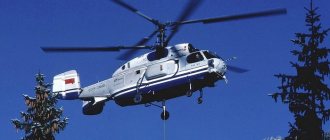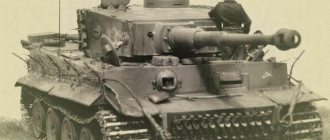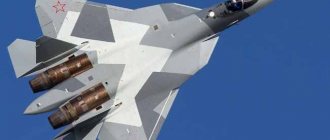An-26 Engine. Weight. Story. Range of flight. Service ceiling
With the advent of the AN-24 passenger aircraft (first flight in October 1959), the creation of its military transport version began. The first version of the light military-technical vehicle, designated An-24T (transport), was converted from the first experimental series of the An-24 in 1961. Instead of a passenger compartment, this aircraft was equipped with a cargo cabin with a reinforced floor and folding seats. For loading and unloading, the entrance and cargo doors available on the original vehicle were used, as well as the new cargo door on the starboard side. Mooring of cargo on board was carried out using nets or lashing straps.
An-12 design
The aerodynamic design of the vehicle is a 4-engine turboprop high-wing aircraft with a tail cargo hatch and a single-fin fin.
The fuselage with a large cargo hatch and a raised tail section ensures convenient loading/unloading of large cargo and their parachute landing. A beam crane (on-board loading device) with a lifting capacity of 2.8 tons and a conveyor speed up and facilitate the processes of mooring, loading and unloading. The fuselage design of the An-12 is almost the same as that of the An-10. The main difference is the rear part of the aircraft, which has a tail gunner mount and a cargo hatch with an air gunner's cabin. In the middle of the fuselage, instead of a passenger compartment, there is a cargo compartment. Moreover, the front part of the vehicle with the cockpit almost completely coincides with the An-10, namely its front part. The crew cabin is sealed and is separated from the cargo cabin by a pressurized frame with a door.
The aircraft's chassis has high maneuverability, which allows it to easily take off from snowy, unpaved and ice airfields. Loading of large cargo and equipment is carried out at the rear of the fuselage through the cargo hatch. The level of the cargo floor of the vehicle is close to the ground thanks to the “high-wing” design, which greatly facilitates and simplifies loading. Unloading and loading are carried out using onboard winches, cargo ladders, a crane beam and a conveyor. For parachute landing on platforms, a conveyor is installed in the vehicle. There are nests on the floor for developing An-12 and An-10. AI-20 engines were chosen for the aircraft.
On December 16, 1957, the first An-12 took off in Irkutsk. Since 1959, it began to be supplied to the Air Force. During its operation, the take-off weight was increased and was already 61 tons.
Design Features
Due to the unification of production of the An-12 and An-10, the middle part of the fuselage of the aircraft with a cargo compartment coincided structurally with the middle part of the fuselage of the An-10 model and was structurally sealed. However, the rear part of the fuselage, which had a cargo hatch, a ramp and was connected to the middle one, was initially leaky. After the production of about a hundred aircraft, the middle part was finally made sealed.
An-26 aircraft - video
The aircraft made it possible to deliver cargo weighing up to 4000 kg, or 37 soldiers, or to drop 33 paratroopers with personal weapons. It could also transport 24 wounded on stretchers and three sitting with two accompanying persons. Factory tests were carried out by test pilot Yu.V. Kurlin. State tests of the aircraft ended in the summer of 1963 with an unsatisfactory rating. The main comments were: the plywood floor, which quickly became unusable after moving cargo, the small radius of action, the impossibility of loading light military equipment and dropping it with a parachute. On February 13, 1965, the MAP issued a decree on the creation of an improved modification of the An-24T. The plane even received a new designation An-34, but it did not catch on. Re-equipment of the serial An-24 began in 1965. Significant changes were made to the design, incl. They organized a cargo hatch 1.4 m wide and 2.72 m long in the rear section, behind which two ventral ridges were installed. A conveyor was placed along the entire length of the new cargo floor, and a loading device appeared on the ceiling. The new An-24T was tested in Kyiv and Fergana. State tests were quite successful, the military came to the conclusion that, in general, the AN-24T meets the requirements. The tests have not yet ended, but serial production of the vehicles has already begun at plant No. 39 in Irkutsk.
In 1966, the Design Bureau began further development of lightweight military-technical equipment. For the new An-26 aircraft, a new rear fuselage section with a large cargo hatch was designed, which was closed by a ramp of the original design. It provided a hermetically sealed closure, served as a ramp for loading self-propelled vehicles, and could slide under the fuselage, allowing loading from the body of a vehicle. This design was patented in 8 countries, including the USA, France and England. To conduct joint tests (in one stage), three An-26 aircraft were built in Kyiv. On May 21, 1969, the crew of Yu.N. Ketov took the first An-26 into the sky for the first time.
In early June, the car was shown at the Le Bourget air show. The aircraft underwent extensive testing and was recommended for serial production, which began in 1968. Construction of the An-26 was carried out at a very high pace - up to 14-16 units per month. A total of 1,398 vehicles of various modifications were produced, including for export. The service of the An-26 began in 1970. There are several known cases of spontaneous opening of the ramp in flight, which occurred both through the fault of the crew and the fault of the manufacturer. The history of the operation of the An-26 included one severe disaster that occurred on May 3, 1985. An-26 and Tu-134 collided in the air, killing 94 people. Based on the An-26, several modifications were created for special purposes and flying laboratories.
History of creation
The experience of armed clashes with Pakistan has convinced the Indian military that its existing cargo planes are poorly suited for supplying high mountain regions. Neither the American S-130 nor the Soviet An-12 were suitable for this. At that time, the USSR produced the An-26 - a machine suitable in size, unpretentious in maintenance and operation, but also poorly suited for high mountains. And when India announced a competition for a new transport aircraft, the Antonov Design Bureau convinced customers that it could produce a higher-altitude modification.
At first, the Soviet side really wanted to fulfill the requirements by refining the “twenty-sixth” - the USSR Air Force showed no interest in the idea, and they did not want to develop a new aircraft for the sake of one export batch. However, the Indians’ demands were very high, and they also wanted the Soviet military to test the aircraft. The order to begin work on the new aircraft was issued in the summer of 1975. The project was given the name An-32.
The first prototype, converted from an An-26, first flew in July the following year.
The flight was successful, but it soon became clear that the AI-20M engines installed on the prototype did not provide the required characteristics. After installing the uprated AI-20DM engines with different propellers, the plane became a ton heavier, and the fuselage structure had to be strengthened and the tail surface area increased. In the fall of 1976, tests began in India.
The flights in the Himalayas were, on the whole, successful, but it turned out that the landing speed had increased, and with the flaps extended there was a risk of stalling. In the summer of 1977, the modified An-32 returned to India to take off into the air at an altitude of 4 km above sea level, carrying 1.5 tons of cargo on board. Moreover, after takeoff it was necessary to actually turn off one engine. The flight was successful, and when the pilots repeated the same thing with a cargo weighing 3.5 tons, the contract was signed. In 1982, serial production of the An-32 began.
Performance characteristics of the An-26
— Chief designer: V.A. Harvardt - First flight: May 21, 1969 - Start of operation: 1973 - Years of production: 1969 - 1986 - Units produced: 1,403
An-26 crew
- 6 people
Passenger capacity of An-26
- up to 38 personnel, or 30 paratroopers, or 24 wounded on stretchers.
An-26 payload
— 5500 kg
Dimensions of An-26
— Length: 23.87 m — Wing span: 29.20 m — Height: 8.575 m — Wing area: 74.98 m²
Weight of An-26
— Empty weight: 15850 kg — Normal take-off weight: 23000 kg — Maximum take-off weight: 24000 kg — Fuel weight in internal tanks: 7080 liters
An-26 engine
— Power plant: 2 × TVD AI-24VT — Engine power: 2 × 2820 (2 × 2074) — Propeller: AV-72T — Propeller diameter: 3.9 m — Auxiliary power unit: 1 × TRD RU-19A-300 — APU thrust: 1 × 800 kgf
Speed of An-26
— Maximum speed: 540 km/h — Cruising speed: 435 km/h
An-26 flight range
— Practical range: 1100 km — Ferry range: 2660 km — Takeoff length: 870 m — Run length: 650 m
Service ceiling of An-26
— 7300 m
An-26 takeoff speed
— 9.2 m/s
Armament of An-26
— Suspension points: 4 beam holders BDZ-34 — Bombs: caliber up to 500 kg
An-12 production
In the Soviet Union, the An-12 was mass-produced only at three aircraft factories:
- in Tashkent (830 copies in the period 1962-72);
- in Irkutsk (155 copies, 1957-62);
- in Voronezh (258 copies, 1962-72).
Representatives of the general designer were:
- in Tashkent - P.V. Balabuev, V.F. Eroshin, N.A. Pogorelov, Kh.G. Sarymsakov, I.G. Ermokhin, Ya.N. Prikhodko;
- in Irkutsk - A.M. Leontyev, A.I. Shivrin, G.A. Lugovoi, V.Z. Bragilevsky;
- in Voronezh - A.M. Kondratyev, N.P. Sobol, Ya.D. Goloborodko, V.P. Teplov.
Interior features
Airlines use the An-26B-100 with a cabin designed for both 31 and 43 passengers. There is also an option with 35 seats in the cabin. In addition to passengers, the liner carries luggage and cargo.
There are such options for the liner: only for transporting cargo, only passenger, capable of carrying 35 people (possibly a different number of passengers, depending on the customer) and delivering cargo.
The cabin of the aircraft has additional sound insulation. It has a toilet, a kitchen, and a luggage compartment. The seats are installed according to the 2+2 scheme. That is, there are 4 seats in a row. Their pairs are located along the sides. There is a passage in the central part.
Salon An-26
A common drawback of the cabin is the lack of luggage racks. A partition is installed between the passenger compartment and the cargo compartment, which can be easily dismantled. In this case, the partition can be rearranged to different places, due to which the number of passenger seats increases or decreases.
The interior trim is made of modern materials. Loudspeaker communication and individual lighting for passengers are provided. Oxygen equipment (masks) has also been installed. In addition to the door through which boarding and disembarking is carried out, there is an emergency hatch.
The plane has a living compartment. It has a toilet, trunk, cupboard and wardrobe. This compartment is separated from the passenger compartment by a thin wall.
Passenger seats are arranged in rows according to a 2-2 pattern, that is, there is a central passage between pairs of seats installed along the sides. There may be several rows. It all depends on the customer. In the most spacious version, the seats are installed in 12 rows. The numbering of seats starts from the seat located on the left side. It looks like this: A, B, C, D.
The seats in the An-26 cabin have the same design that is used on large airliners. Their backs recline, armrests rise. Individual folding tables are located in the backs of the seats in front. The exception is the first row seats. Here the tables are built into the armrests.
Of course, there is no need to talk about any special comfort in the cabin of the An-26, but still, there are better and worse places here. Passengers in the first row have the most convenience. They have more legroom. However, armrests that do not rise reduce comfort. In addition, those in seats adjacent to the aisle find it somewhat boring during the flight. There is a wall in front of them.
Passengers sitting at the windows are in a better position. Since the An-26 does not rise to a height from which nothing is visible except the clouds below, they can admire the paintings floating below.
Seats in the last, 12th row are considered uncomfortable. Immediately behind them there is a partition, behind which there is a toilet and other household premises.
Of course, since there are not many passengers in the cabin, there is no need to talk about the queue for the toilet in the aisles, but still, passengers appear here from time to time, disturbing those sitting at the aisle.
An-26 passenger seat layout




